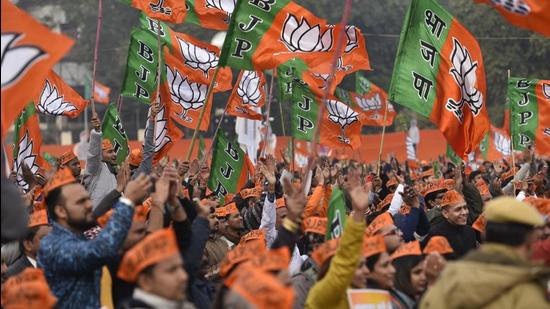OBCs: The key to the BJP’s electoral strategy in UP
The BJP slogan of sabka sath, sabka vikas (development for all) will undoubtedly continue to be the overarching theme alongside the caste calculations
Why has a Bharatiya Janata Party (BJP) member of the legislative assembly (MLA) from Gorakhpur — whose name was in the frame for the likely state cabinet expansion in August — started adding “Sainthwar” to his name as the elections approach? Why has former Uttarakhand governor, BJP national vice president, and the party’s prominent Dalit face Baby Rani Maurya added ‘Jatav’ to her name?

Almost all observers agree that in preparations for the 2022 Uttar Pradesh (UP) elections, the BJP is far ahead of its challengers. The opposition parties are divided and lack well-oiled party machines. Yet, despite starting from a position of strength, the BJP is nervous. It fears that it will lose many seats in western UP because of the farmers’ agitation. To counter this, it is trying to increase its appeal among different caste constituencies and focusing its efforts on eastern UP. Office-bearers of BJP’s Scheduled Castes and Backward Classes Front report that over the last few months intense caste calculations have taken place and resulted in numerous organisational changes and reshuffles. The BJP is particularly targeting non-Yadav OBC voters. The recent efforts to seal an alliance with the Nishad Party and the Apna Dal are just few indicators.
Onkar Nath Tripathi, a freelance journalist and political analyst in Gorakhpur, believes that “casteism will be at its peak in the 2022 assembly elections and the BJP will be able to capitalise it in its favour. Upper castes like Brahmins and Rajputs will shun the Samajwadi Party and the Bahujan Samaj Party due to social prestige and history. Om Prakash Rajbhar of the Rajbhar community, with a sizeable presence in a score of constituencies in eastern UP, is the only thorn in the flesh for the BJP so far.”
The BJP’s success in state politics results from a synchronisation between the grand narrative of Hindutva and the micromanagement of caste equations at the ground level. Since 2014, the party has realised the electoral importance of the numerically large but fragmented OBC block for the party’s future in the state.
In fact, the party has long striven to increase its penetration among the backward castes. A senior functionary of Vanvasi Kalyan Ashram in Varanasi, Ghansyam Pandey, stated that efforts in this direction began in the 1960s under the leadership of the Jan Sangh leader, Deendayal Upadhyay. Subsequently, the BJP tried to woo OBCs through the recently deceased Kalyan Singh in western UP and Uma Bharati in Bundelkhand. Second-rank leaders, such as Om Prakash Singh and Vinay Katiyar in eastern UP, were at the forefront of the party organisation as a demonstration to OBCs that the party was well aware of the aspirations of castes other than the Yadavs and Chamars. It was no coincidence that Kalyan Singh, an OBC from western UP’s Lodh community, was made the state unit president in 1984 and unanimously chosen to be the chief minister in 1991.
There was a change in strategy after Amit Shah took charge of the BJP organisation in 2014. There was a marked increase in “micro management”, with responsibilities assigned to the rank and file. He reorganised the constituent units of the party along the parliamentary constituency, assembly constituency, district circles, and mandal in wards and villages. The aim was to focus on every voting booth. Booth jeeto, chunav jeeto (win booth, win election) is the new anthem of the party. With more than 1,40,000 booth committees having 21 members per booth, the party has built a solid structure of committed workers in the state.
The caste calculus is the key consideration for appointments at the booth level. In the recent past the BJP has been open about its strategy.
Bhushan, a local activist of the Dhangar community in eastern Uttar Pradesh, stated, “If one examines carefully, the BJP has stuffed the local organisation with OBC leaders. The only exception to this could be the IT cell.”
In the rural constituencies, the BJP targets the gram pradhan (elected village head) and the former pradhan for managing the caste equation. The mobile numbers and other contact details of the panchayat functionaries are coordinated with the BJP organisation so that voters of every class and caste of the village can be covered. Piyush Chaturvedi, an ex-gram pradhan of Mangalpur village in Kushinagar, summarised the BJP’s strategy: “As we see in action movies how a specific car is piloted by surrounding cars to move in a desired direction, similarly the BJP pilots its voters to the voting booth and leaves them no option but to vote in its favour.”
The state administration is also mobilised along caste lines. A respondent from the mushahar community in Kushinagar district said that the administration (mainly the Block Development Officer) should make sure that only correct beneficiaries take advantage of government schemes.
A district-level senior party functionary of the BJP in Fazilnagar constituency of Kushinagar district, Radhey Shyam Pandey, admits that the middle class is unhappy because of price inflation, particularly of gasoline and cereals, but the party has mobilised caste at the grassroots level to the extent that it has become a party of rural aspiration.
The BJP slogan of sabka sath, sabka vikas (development for all) will undoubtedly continue to be the overarching theme alongside the caste calculations.
The opposition, especially the SP and the Congress, seem to be finally beginning their campaigns. We must wait for another turn of the wheel of democracy to know who will have the last laugh.
Shashank Chaturvedi is at Tata Institute of Social Sciences, Patna; Sanjay Kumar Pandey is at the Jawaharlal Nehru University; and David N. Gellner is at the University of Oxford.
The views expressed are personal






